Abstract
Reductions in bone density are a major determinant of vertebral fractures in the elderly population. However, women have a greater incidence of fractures than men, although their spinal bone densities are comparable. Recent observations indicate that women have 20-25% smaller vertebrae than men after accounting for differences in body size. To assess whether elderly women with vertebral fractures have smaller vertebrae than women who do not experience fractures, we reviewed 1,061 computed tomography bone density studies and gathered 32-matched pairs of elderly women, with reduced bone density, whose main difference was absence or presence of vertebral fractures. Detailed measurements of the dimensions of unfractured vertebrae and the moment arm of spinal musculature from T12 to L4 were calculated from computed tomography images in the 32 pairs of women matched for race, age, height, weight, and bone density. The cross-sectional area of unfractured vertebrae was 4.9-11.5% (10.5 +/- 1.4 vs 9.7 +/- 1.5 cm2; P < 0.0001) smaller and the moment arm of spinal musculature was 3.2-7.4% (56.4 +/- 5.1 vs 53.1 +/- 4.4 mm; P < 0.0001) shorter in women with fractures, implying that mechanical stress within intact vertebral bodies for equivalent loads is 5-17% greater in women with fractures compared to women without fractures. Such significant variations are very likely to contribute to vertebral fractures in osteoporotic women.
Full text
PDF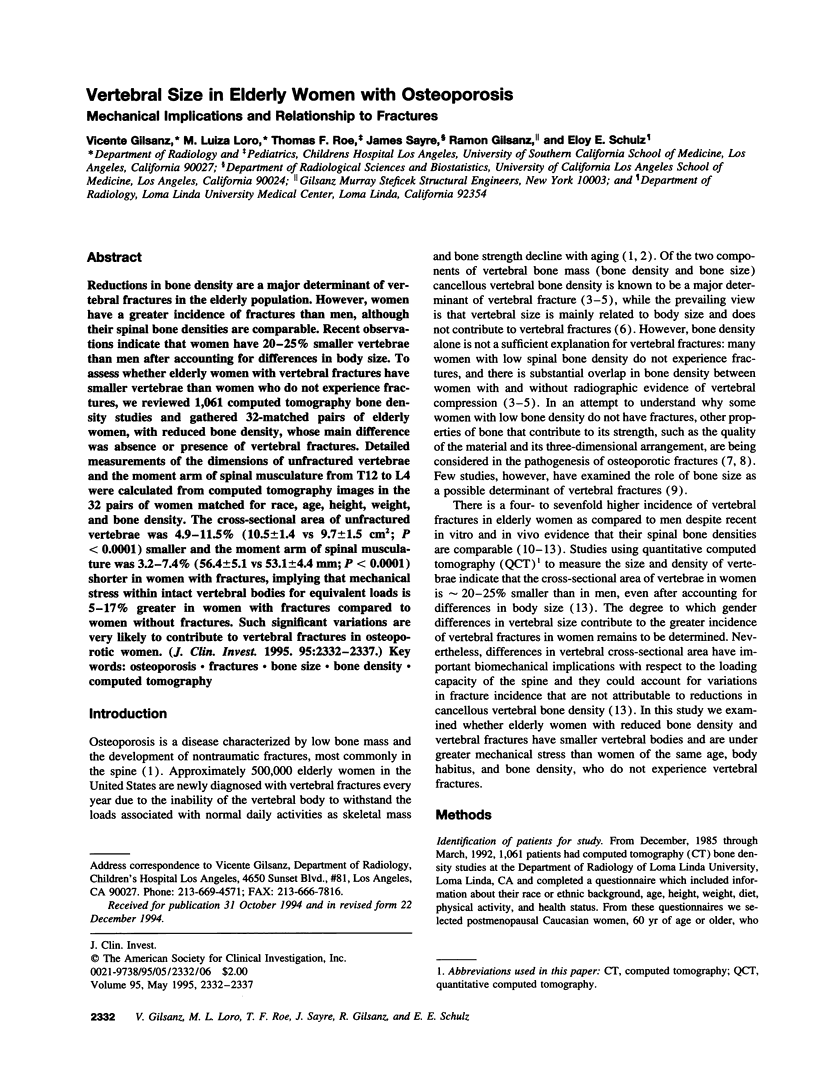
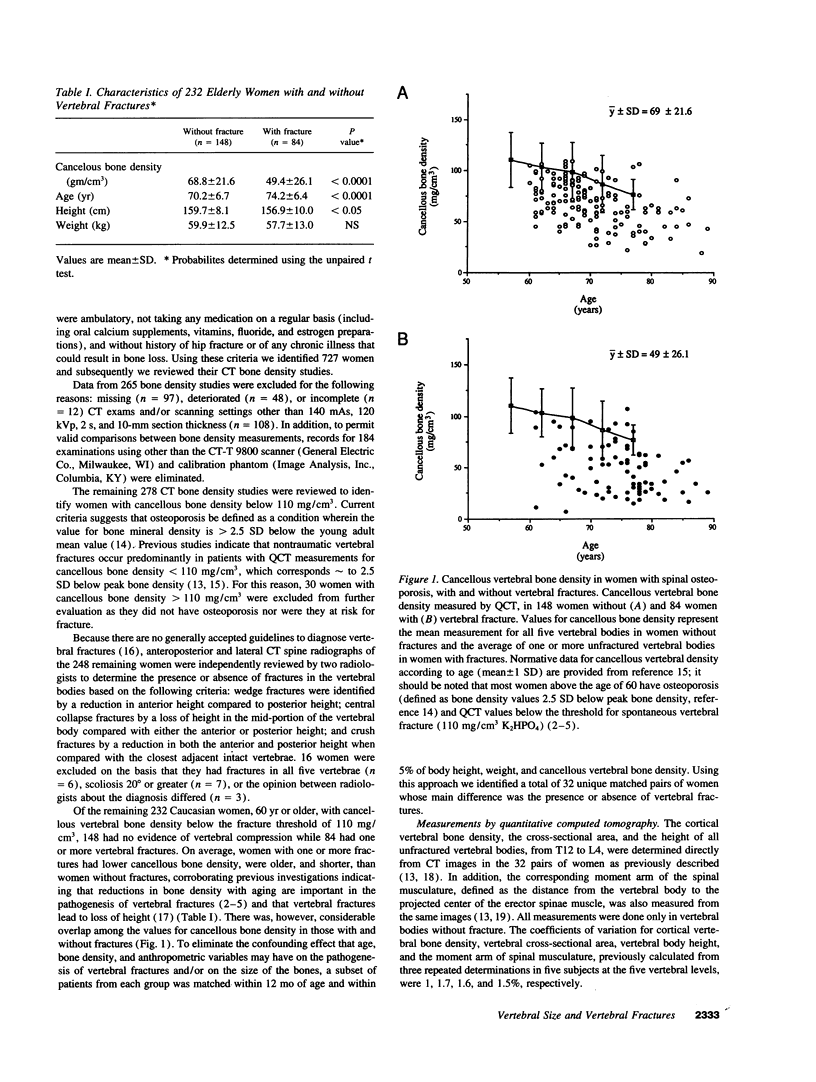
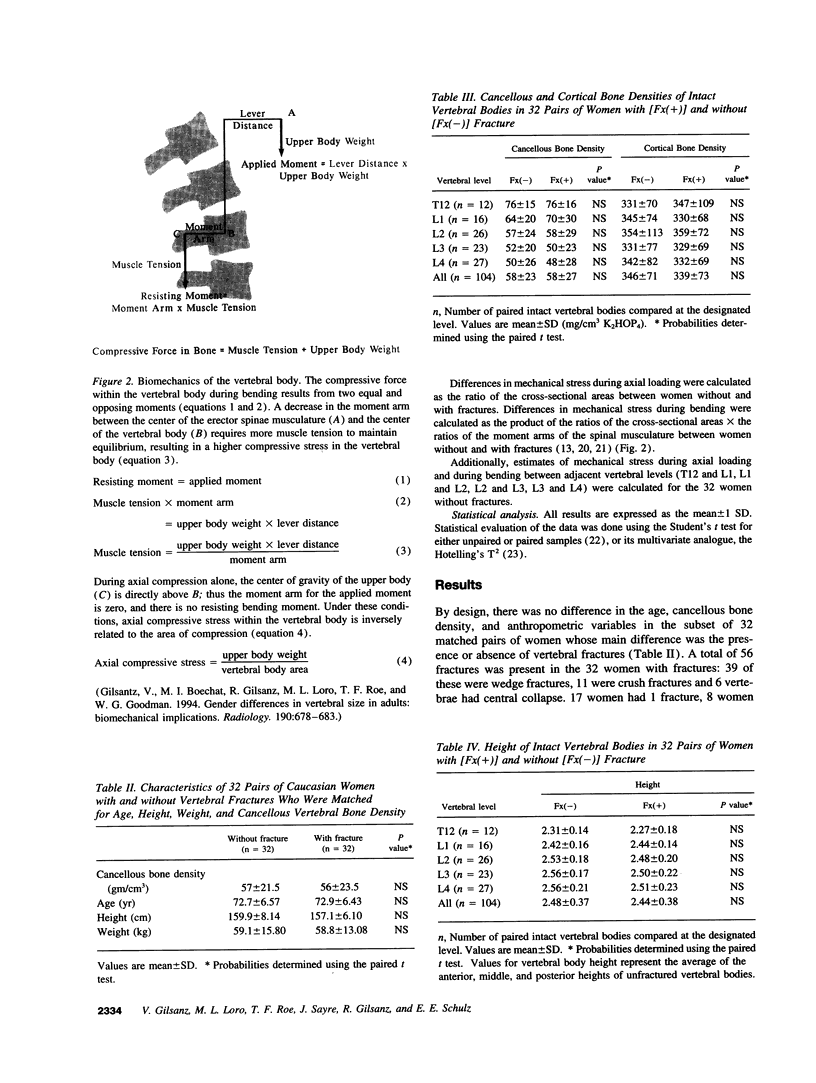
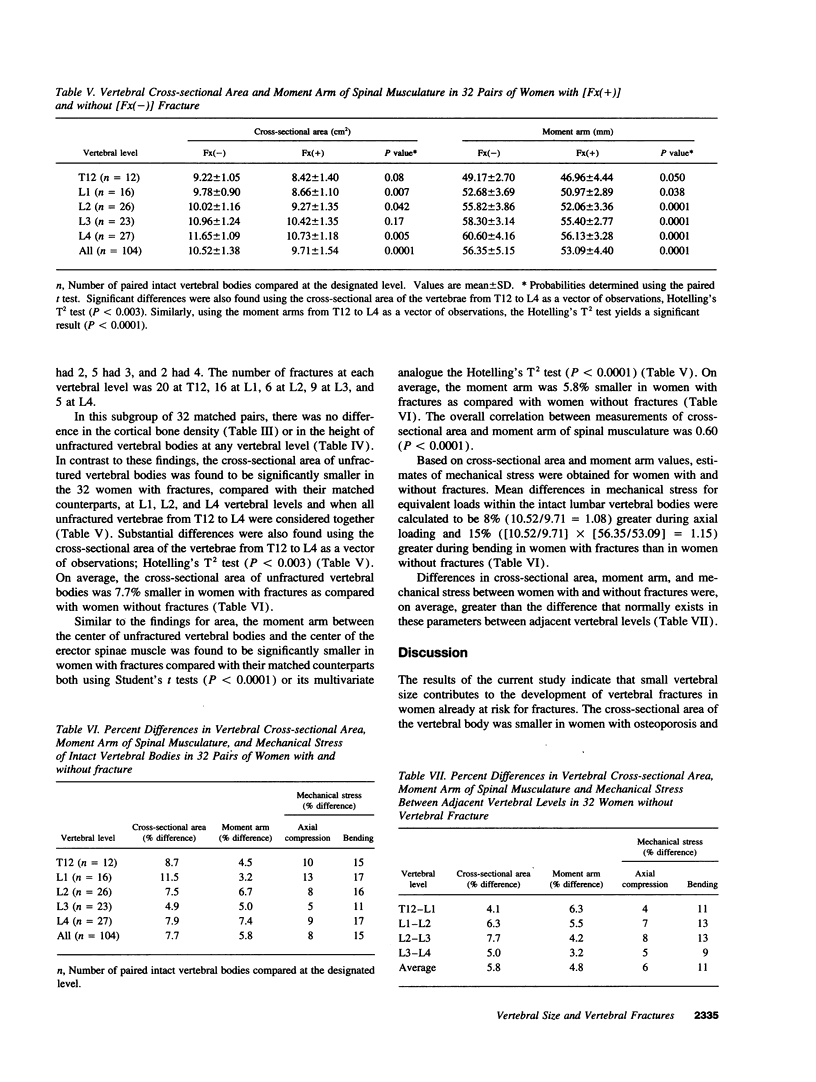
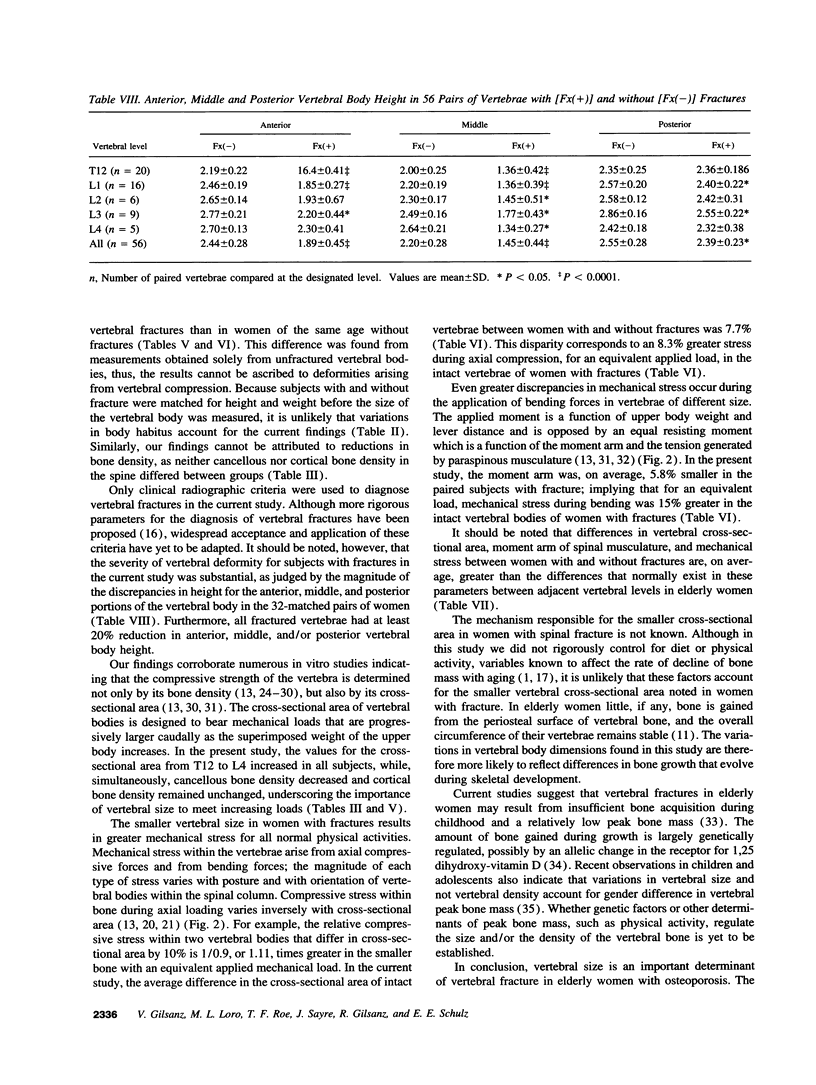
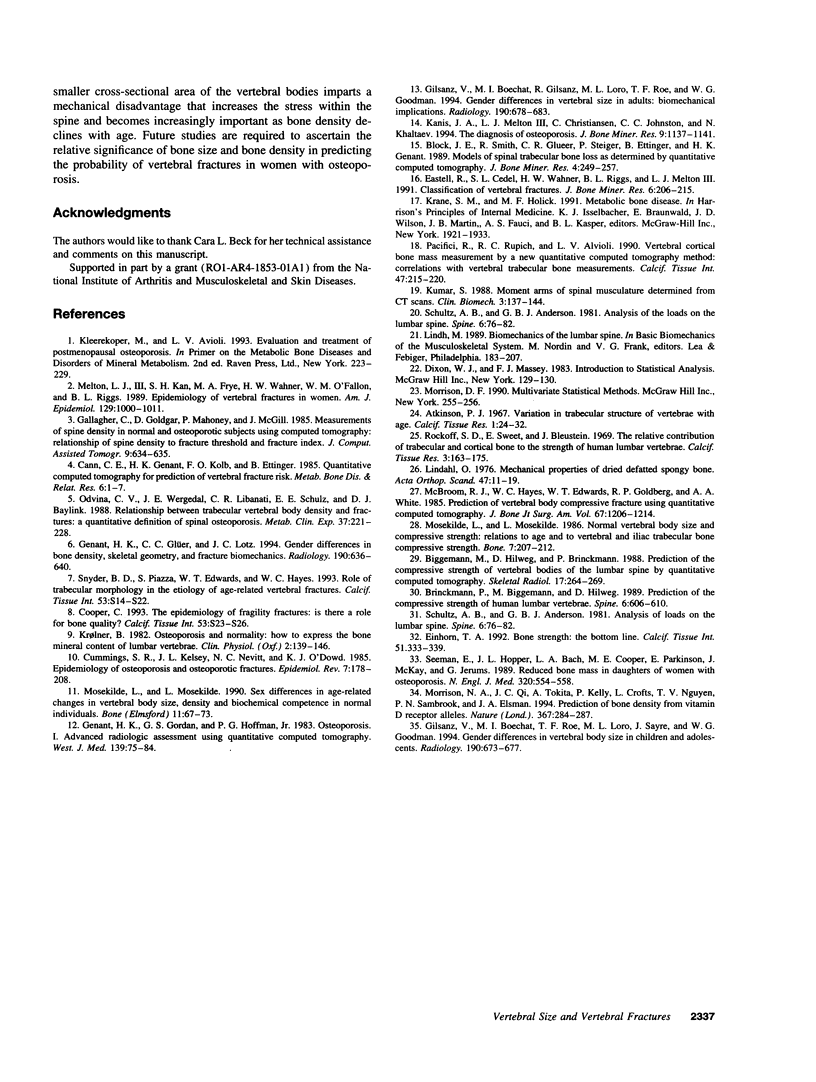
Images in this article
Selected References
These references are in PubMed. This may not be the complete list of references from this article.
- Atkinson P. J. Variation in trabecular structure of vertebrae with age. Calcif Tissue Res. 1967;1(1):24–32. doi: 10.1007/BF02008071. [DOI] [PubMed] [Google Scholar]
- Biggemann M., Hilweg D., Brinckmann P. Prediction of the compressive strength of vertebral bodies of the lumbar spine by quantitative computed tomography. Skeletal Radiol. 1988;17(4):264–269. doi: 10.1007/BF00401809. [DOI] [PubMed] [Google Scholar]
- Block J. E., Smith R., Glueer C. C., Steiger P., Ettinger B., Genant H. K. Models of spinal trabecular bone loss as determined by quantitative computed tomography. J Bone Miner Res. 1989 Apr;4(2):249–257. doi: 10.1002/jbmr.5650040218. [DOI] [PubMed] [Google Scholar]
- Brinckmann P., Biggemann M., Hilweg D. Prediction of the compressive strength of human lumbar vertebrae. Spine (Phila Pa 1976) 1989 Jun;14(6):606–610. [PubMed] [Google Scholar]
- Cann C. E., Genant H. K., Kolb F. O., Ettinger B. Quantitative computed tomography for prediction of vertebral fracture risk. Bone. 1985;6(1):1–7. doi: 10.1016/8756-3282(85)90399-0. [DOI] [PubMed] [Google Scholar]
- Cooper C. The epidemiology of fragility fractures: is there a role for bone quality? Calcif Tissue Int. 1993;53 (Suppl 1):S23–S26. doi: 10.1007/BF01673397. [DOI] [PubMed] [Google Scholar]
- Cummings S. R., Kelsey J. L., Nevitt M. C., O'Dowd K. J. Epidemiology of osteoporosis and osteoporotic fractures. Epidemiol Rev. 1985;7:178–208. doi: 10.1093/oxfordjournals.epirev.a036281. [DOI] [PubMed] [Google Scholar]
- Eastell R., Cedel S. L., Wahner H. W., Riggs B. L., Melton L. J., 3rd Classification of vertebral fractures. J Bone Miner Res. 1991 Mar;6(3):207–215. doi: 10.1002/jbmr.5650060302. [DOI] [PubMed] [Google Scholar]
- Einhorn T. A. Bone strength: the bottom line. Calcif Tissue Int. 1992 Nov;51(5):333–339. doi: 10.1007/BF00316875. [DOI] [PubMed] [Google Scholar]
- Genant H. K., Glüer C. C., Lotz J. C. Gender differences in bone density, skeletal geometry, and fracture biomechanics. Radiology. 1994 Mar;190(3):636–640. doi: 10.1148/radiology.190.3.8115602. [DOI] [PubMed] [Google Scholar]
- Gilsanz V., Boechat M. I., Gilsanz R., Loro M. L., Roe T. F., Goodman W. G. Gender differences in vertebral sizes in adults: biomechanical implications. Radiology. 1994 Mar;190(3):678–682. doi: 10.1148/radiology.190.3.8115610. [DOI] [PubMed] [Google Scholar]
- Gilsanz V., Boechat M. I., Roe T. F., Loro M. L., Sayre J. W., Goodman W. G. Gender differences in vertebral body sizes in children and adolescents. Radiology. 1994 Mar;190(3):673–677. doi: 10.1148/radiology.190.3.8115609. [DOI] [PubMed] [Google Scholar]
- Kanis J. A., Melton L. J., 3rd, Christiansen C., Johnston C. C., Khaltaev N. The diagnosis of osteoporosis. J Bone Miner Res. 1994 Aug;9(8):1137–1141. doi: 10.1002/jbmr.5650090802. [DOI] [PubMed] [Google Scholar]
- Lindahl O. Mechanical properties of dried defatted spongy bone. Acta Orthop Scand. 1976 Feb;47(1):11–19. doi: 10.3109/17453677608998966. [DOI] [PubMed] [Google Scholar]
- McBroom R. J., Hayes W. C., Edwards W. T., Goldberg R. P., White A. A., 3rd Prediction of vertebral body compressive fracture using quantitative computed tomography. J Bone Joint Surg Am. 1985 Oct;67(8):1206–1214. [PubMed] [Google Scholar]
- Melton L. J., 3rd, Kan S. H., Frye M. A., Wahner H. W., O'Fallon W. M., Riggs B. L. Epidemiology of vertebral fractures in women. Am J Epidemiol. 1989 May;129(5):1000–1011. doi: 10.1093/oxfordjournals.aje.a115204. [DOI] [PubMed] [Google Scholar]
- Morrison N. A., Qi J. C., Tokita A., Kelly P. J., Crofts L., Nguyen T. V., Sambrook P. N., Eisman J. A. Prediction of bone density from vitamin D receptor alleles. Nature. 1994 Jan 20;367(6460):284–287. doi: 10.1038/367284a0. [DOI] [PubMed] [Google Scholar]
- Mosekilde L., Mosekilde L. Normal vertebral body size and compressive strength: relations to age and to vertebral and iliac trabecular bone compressive strength. Bone. 1986;7(3):207–212. doi: 10.1016/8756-3282(86)90019-0. [DOI] [PubMed] [Google Scholar]
- Mosekilde L., Mosekilde L. Sex differences in age-related changes in vertebral body size, density and biomechanical competence in normal individuals. Bone. 1990;11(2):67–73. doi: 10.1016/8756-3282(90)90052-z. [DOI] [PubMed] [Google Scholar]
- Odvina C. V., Wergedal J. E., Libanati C. R., Schulz E. E., Baylink D. J. Relationship between trabecular vertebral body density and fractures: a quantitative definition of spinal osteoporosis. Metabolism. 1988 Mar;37(3):221–228. doi: 10.1016/0026-0495(88)90099-6. [DOI] [PubMed] [Google Scholar]
- Osteoporosis. Part I. Advanced radiologic assessment using quantitative computed tomography. West J Med. 1983 Jul;139(1):75–84. [PMC free article] [PubMed] [Google Scholar]
- Pacifici R., Rupich R. C., Avioli L. V. Vertebral cortical bone mass measurement by a new quantitative computer tomography method: correlations with vertebral trabecular bone measurements. Calcif Tissue Int. 1990 Oct;47(4):215–220. doi: 10.1007/BF02555922. [DOI] [PubMed] [Google Scholar]
- Rockoff S. D., Sweet E., Bleustein J. The relative contribution of trabecular and cortical bone to the strength of human lumbar vertebrae. Calcif Tissue Res. 1969;3(2):163–175. doi: 10.1007/BF02058659. [DOI] [PubMed] [Google Scholar]
- Schultz A. B., Andersson G. B. Analysis of loads on the lumbar spine. Spine (Phila Pa 1976) 1981 Jan-Feb;6(1):76–82. doi: 10.1097/00007632-198101000-00017. [DOI] [PubMed] [Google Scholar]
- Schultz A. B., Andersson G. B. Analysis of loads on the lumbar spine. Spine (Phila Pa 1976) 1981 Jan-Feb;6(1):76–82. doi: 10.1097/00007632-198101000-00017. [DOI] [PubMed] [Google Scholar]
- Seeman E., Hopper J. L., Bach L. A., Cooper M. E., Parkinson E., McKay J., Jerums G. Reduced bone mass in daughters of women with osteoporosis. N Engl J Med. 1989 Mar 2;320(9):554–558. doi: 10.1056/NEJM198903023200903. [DOI] [PubMed] [Google Scholar]
- Snyder B. D., Piazza S., Edwards W. T., Hayes W. C. Role of trabecular morphology in the etiology of age-related vertebral fractures. Calcif Tissue Int. 1993;53 (Suppl 1):S14–S22. doi: 10.1007/BF01673396. [DOI] [PubMed] [Google Scholar]



